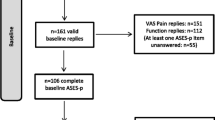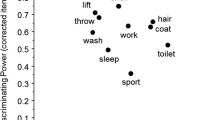Abstract
The modified American Shoulder and Elbow Surgeon’s (M-ASES) questionnaire is purported to be a non-region specific functional measure of the entire upper extremity. The purpose of this study was to determine the factor structure of the M-ASES and to determine item-fit of the M-ASES using item response theory (IRT). Analyses included univariate baseline demographics, factor analysis, convergent/construct validation with the SF-12, and graded response IRT of the M-ASES. 964 patients of an orthopedic practice with a variety of upper extremity dysfunctions participated in this trial. The M-ASES demonstrated two dimensions (wrist/hand and shoulder dysfunction) and exhibited excellent discrimination and threshold specification. The instrument correlated well with the mental and physical dimensions of the SF-12. The M-ASES should be considered an excellent tool for measure of whole upper extremity dysfunction.
Similar content being viewed by others
References
Beaton D, Richards RR (1998) Assessing the reliability and responsiveness of 5 shoulder questionnaires. J Shoulder Elbow Surg 7:565–572
Beaton DE, Wright JG, Katz JN (2005) Development of the QuickDASH: comparison of three item-reduction approaches. J Bone Joint Surg Am 87:1038–1046
Bhakta B, Tennant A, Horton M, Lawton G, Andrich D (2005) Using item response theory to explore the psychometric properties of extended matching questions examination in undergraduate medical education. BMC Med Educ 5:9
Bot SD, Terwee CB, van der Windt DA, Bouter LM, Dekker J, de Vet HC (2004) Clinimetric evaluation of shoulder disability questionnaires: a systematic review of the literature. Ann Rheum Dis 63:335–341
Chang CH, Reeve BB (2005) Item response theory and its applications to patient-reported outcomes measurement. Eval Health Prof 28:264–282
Cook KF, Gartsman GM, Roddey TS, Olson SL (2001) The measurement level and trait-specific reliability of 4 scales of shoulder functioning: an empiric investigation. Arch Phys Med Rehabil 82:1558–1565
Dowrick AS, Gabbe BJ, Williamson OD, Cameron PA (2005) Outcome instruments for the assessment of the upper extremity following trauma: a review. Injury 36:468–476
Embretson S, Reise S (2000) Item response theory for psychologists. Hillsdale, Erlbaum
Hays RD, Morales LS, Reise SP (2000) Item response theory and health outcomes measurement in the 21st century. Med Care 38:II28–II42
Holbrook M, Skilbeck CE (1983) An activities index for use with stroke patients. Age Ageing 12:166–170
Kocher MS, Horan MP, Briggs KK, Richardson TR, O’Holleran J, Hawkins RJ (2005) Reliability, validity, and responsiveness of the American Shoulder and Elbow Surgeons subjective shoulder scale in patients with shoulder instability, rotator cuff disease, and glenohumeral arthritis. J Bone Joint Surg Am 87:2006–2011
Liang MH (2000) Longitudinal construct validity: establishment of clinical meaning in patient evaluative instruments. Med Care 38:II84–II90
Masters G (1982) A Rasch model for partial credit scoring. Psychometrika 47:149–173
McClure P, Michener L (2003) Measures of adult shoulder function. Arthritis Rheum 49:50–58
McHorney C, Ware JJ, Lu J, Sherbourne C (1994) The MOS 36-item Short-Form Health Survey (SF-36): III. Tests of data quality, scaling assumptions, and reliability across diverse patient groups. Med Care 32:40–66
McHorney CA, Ware JE Jr, Raczek AE (1993) The MOS 36-Item Short-Form Health Survey (SF-36): II. Psychometric and clinical tests of validity in measuring physical and mental health constructs. Med Care 31:247–263
Mellenbergh G (1994) Generalized linear item response theory. Psychol Bull 15:300–307
Michener LA, McClure PW, Sennett BJ (2002) American Shoulder and Elbow Surgeons Standardized Shoulder Assessment Form, patient self-report section: reliability, validity, and responsiveness. J Shoulder Elbow Surg 11:587–594
Patrick DL, Chiang YP (2000) Measurement of health outcomes in treatment effectiveness evaluations: conceptual and methodological challenges. Med Care 38:II14–II25
Pietrobon R, Coeytaux RR, Carey TS, Richardson WJ, DeVellis RF (2002) Standard scales for measurement of functional outcome for cervical pain or dysfunction: a systematic review. Spine 27:515–522
Razmjou H, Bean A, van Osnabrugge V, MacDermid JC, Holtby R (2006) Cross-sectional and longitudinal construct validity of two rotator cuff disease-specific outcome measures. BMC Musculoskelet Disord 7:26
Richards R, An K, Bigliani L et al (1994) A standardized method for the assessment of shoulder function. J Shoulder Elbow Surg 3:347–352
Sallay PI, Reed L (2003) The measurement of normative American Shoulder and Elbow Surgeons scores. J Shoulder Elbow Surg 12:622–627
Steinberg L, Thissen D (1995) Item response theory in personality research. In: Fisk S (ed) Personality research, methods, and theory. Hillsdale, Erlbaum
van der Linden W, Hambleton R (1997) Handbook of modern item response theory. New York, Springer
Ware J Jr, Kosinski M, Keller SD (1996) A 12-Item Short-Form Health Survey: construction of scales and preliminary tests of reliability and validity. Med Care 34:220–233
Ware JE Jr, Sherbourne CD (1992) The MOS 36-item short-form health survey (SF-36). I. Conceptual framework and item selection. Med Care 30:473–483
Author information
Authors and Affiliations
Corresponding author
Rights and permissions
About this article
Cite this article
Cook, C., Hegedus, E., Goode, A. et al. Relative validity of the modified American Shoulder and Elbow Surgeons (M-ASES) questionnaire using item response theory. Rheumatol Int 28, 217–223 (2008). https://doi.org/10.1007/s00296-007-0420-8
Received:
Accepted:
Published:
Issue Date:
DOI: https://doi.org/10.1007/s00296-007-0420-8




